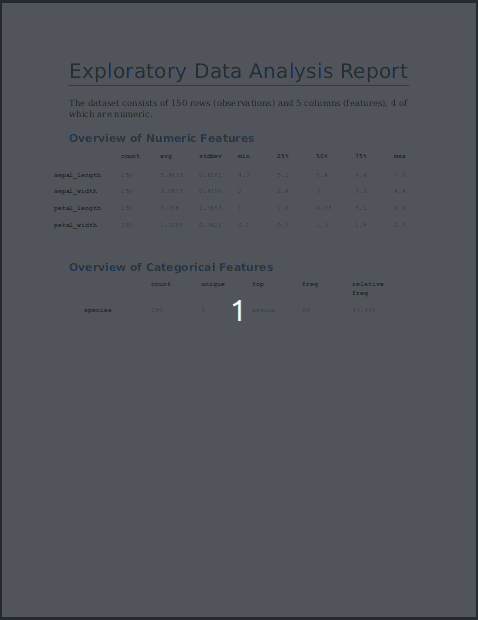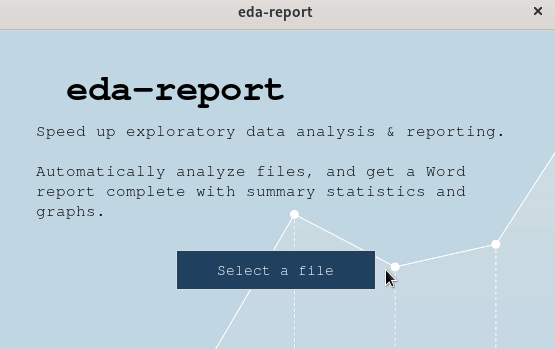
Security News
Browserslist-rs Gets Major Refactor, Cutting Binary Size by Over 1MB
Browserslist-rs now uses static data to reduce binary size by over 1MB, improving memory use and performance for Rust-based frontend tools.
eda-report - Automated Exploratory Data AnalysisA Python program to help automate the exploratory data analysis and reporting process.
Input data is analyzed using pandas and SciPy. Graphs are plotted using matplotlib. The results are then nicely packaged as a Word (.docx) document using python-docx.

You can install the package from PyPI using:
pip install eda-report
The eda-report command launches a graphical window to help select a csv/excel file to analyze:
eda-report

You'll be prompted to set a report title, group-by/target variable (optional), graph color and output filename; after which the contents of the input file are analyzed, and the results saved in a Word (.docx) document.
NOTE: For help with
Tk- related issues, consider visiting TkDocs.
$ eda-report -i iris.csv -o iris-report.docx
Analyze variables: 100%|███████████████████████████████████| 5/5
Plot variables: 100%|███████████████████████████████████| 5/5
Bivariate analysis: 100%|███████████████████████████████████| 6/6 pairs.
[INFO 02:12:22.146] Done. Results saved as 'iris-report.docx'
$ eda-report -h
usage: eda-report [-h] [-i INFILE] [-o OUTFILE] [-t TITLE] [-c COLOR]
[-g GROUPBY]
Automatically analyze data and generate reports. A graphical user interface
will be launched if none of the optional arguments is specified.
optional arguments:
-h, --help show this help message and exit
-i INFILE, --infile INFILE
A .csv or .xlsx file to analyze.
-o OUTFILE, --outfile OUTFILE
The output name for analysis results (default: eda-
report.docx)
-t TITLE, --title TITLE
The top level heading for the report (default:
Exploratory Data Analysis Report)
-c COLOR, --color COLOR
The color to apply to graphs (default: cyan)
-g GROUPBY, -T GROUPBY, --groupby GROUPBY, --target GROUPBY
The variable to use for grouping plotted values. An
integer value is treated as a column index, whereas a
string is treated as a column label.
>>> eda_report.summarize(iris_data)
Summary Statistics for Numeric features (4)
-------------------------------------------
count avg stddev min 25% 50% 75% max skewness kurtosis
sepal_length 150 5.8433 0.8281 4.3 5.1 5.80 6.4 7.9 0.3149 -0.5521
sepal_width 150 3.0573 0.4359 2.0 2.8 3.00 3.3 4.4 0.3190 0.2282
petal_length 150 3.7580 1.7653 1.0 1.6 4.35 5.1 6.9 -0.2749 -1.4021
petal_width 150 1.1993 0.7622 0.1 0.3 1.30 1.8 2.5 -0.1030 -1.3406
Summary Statistics for Categorical features (1)
-----------------------------------------------
count unique top freq relative freq
species 150 3 setosa 50 33.33%
Pearson's Correlation (Top 20)
------------------------------
petal_length & petal_width -> very strong positive correlation (0.96)
sepal_length & petal_length -> very strong positive correlation (0.87)
sepal_length & petal_width -> very strong positive correlation (0.82)
sepal_width & petal_length -> moderate negative correlation (-0.43)
sepal_width & petal_width -> weak negative correlation (-0.37)
sepal_length & sepal_width -> very weak negative correlation (-0.12)
Check out the documentation for more features and details.
FAQs
Automate exploratory data analysis and reporting.
We found that eda-report demonstrated a healthy version release cadence and project activity because the last version was released less than a year ago. It has 1 open source maintainer collaborating on the project.
Did you know?

Socket for GitHub automatically highlights issues in each pull request and monitors the health of all your open source dependencies. Discover the contents of your packages and block harmful activity before you install or update your dependencies.

Security News
Browserslist-rs now uses static data to reduce binary size by over 1MB, improving memory use and performance for Rust-based frontend tools.

Research
Security News
Eight new malicious Firefox extensions impersonate games, steal OAuth tokens, hijack sessions, and exploit browser permissions to spy on users.

Security News
The official Go SDK for the Model Context Protocol is in development, with a stable, production-ready release expected by August 2025.